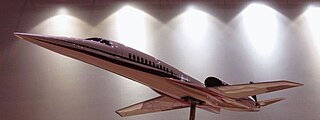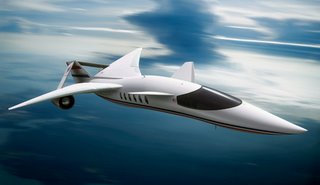
Concorde is a retired Anglo-French supersonic airliner jointly developed and manufactured by Sud Aviation and the British Aircraft Corporation (BAC). Studies started in 1954, and France and the UK signed a treaty establishing the development project on 29 November 1962, as the programme cost was estimated at £70 million . Construction of the six prototypes began in February 1965, and the first flight took off from Toulouse on 2 March 1969. The market was predicted for 350 aircraft, and the manufacturers received up to 100 option orders from many major airlines. On 9 October 1975, it received its French Certificate of Airworthiness, and from the UK CAA on 5 December.

A jet aircraft is an aircraft propelled by one or more jet engines.

A supersonic transport (SST) or a supersonic airliner is a civilian supersonic aircraft designed to transport passengers at speeds greater than the speed of sound. To date, the only SSTs to see regular service have been Concorde and the Tupolev Tu-144. The last passenger flight of the Tu-144 was in June 1978 and it was last flown in 1999 by NASA. Concorde's last commercial flight was in October 2003, with a November 26, 2003 ferry flight being its last airborne operation. Following the permanent cessation of flying by Concorde, there are no remaining SSTs in commercial service. Several companies have each proposed a supersonic business jet, which may bring supersonic transport back again.

A scramjet is a variant of a ramjet airbreathing jet engine in which combustion takes place in supersonic airflow. As in ramjets, a scramjet relies on high vehicle speed to compress the incoming air forcefully before combustion, but where as a ramjet decelerates the air to subsonic velocities before combustion using shock cones, a scramjet has no shock cone and slows the airflow using shockwaves produced by its ignition source in place of a shock cone. This allows the scramjet to operate efficiently at extremely high speeds.

The NASA X-43 was an experimental unmanned hypersonic aircraft with multiple planned scale variations meant to test various aspects of hypersonic flight. It was part of the X-plane series and specifically of NASA's Hyper-X program developed in the late 1990s. It set several airspeed records for jet aircraft. The X-43 is the fastest jet-powered aircraft on record at approximately Mach 9.6.

An airplane or aeroplane, informally plane, is a fixed-wing aircraft that is propelled forward by thrust from a jet engine, propeller, or rocket engine. Airplanes come in a variety of sizes, shapes, and wing configurations. The broad spectrum of uses for airplanes includes recreation, transportation of goods and people, military, and research. Worldwide, commercial aviation transports more than four billion passengers annually on airliners and transports more than 200 billion tonne-kilometers of cargo annually, which is less than 1% of the world's cargo movement. Most airplanes are flown by a pilot on board the aircraft, but some are designed to be remotely or computer-controlled such as drones.

A supersonic aircraft is an aircraft capable of supersonic flight, that is, flying faster than the speed of sound. Supersonic aircraft were developed in the second half of the twentieth century. Supersonic aircraft have been used for research and military purposes, but only two supersonic aircraft, the Tupolev Tu-144 and the Concorde, ever entered service for civil use as airliners. Fighter jets are the most common example of supersonic aircraft.
Aerion Corporation was an American aircraft manufacturer based in Reno, Nevada. It was founded by Robert Bass of Fort Worth.

A supersonic business jet (SSBJ) is a business jet travelling above the speed of sound: a supersonic aircraft. Some manufacturers are designing or have been designing SSBJs, but none are currently available. Usually intended to transport about ten passengers, proposed SSBJs would be about the same size as subsonic business jets.
Scramjet programs refers to research and testing programs for the development of supersonic combustion ramjets, known as scramjets. This list provides a short overview of national and international collaborations, and civilian and military programs. The USA, Russia, India, and China (2014), have succeeded at developing scramjet technologies.

The SAI Quiet Supersonic Transport (QSST) was a project by Supersonic Aerospace International (SAI) to develop a "virtually boomless" commercial supersonic business jet. The project was announced around the year 2000 and provided update announcements until 2010. After three years without any updates, the last update was in 2013. As of 2023, there have been no more updates, and the project appears to have been abandoned.

A hydrogen-powered aircraft is an aeroplane that uses hydrogen fuel as a power source. Hydrogen can either be burned in a jet engine or another kind of internal combustion engine, or can be used to power a fuel cell to generate electricity to power an electric propulsor. It cannot be stored in a traditional wet wing, and hydrogen tanks have to be housed in the fuselage or be supported by the wing.
The Avion de Transport Supersonique Futur (ATSF) also known as Alliance, was a concept design for supersonic transport that was being worked on by both British Aerospace and Aérospatiale. The aircraft was to be based on the experience learned from the supersonic Concorde, and was to fly at a top speed of roughly Mach 2. Preliminary designs were produced, with some wind-tunnel testing of small-scale models, but development apparently stalled in the early 2000s.

The Reaction Engines Limited LAPCAT Configuration A2 is a design study for a hypersonic speed jet airliner intended to provide long range, high capacity commercial transportation.
An airbreathing jet engine is a jet engine in which the exhaust gas which supplies jet propulsion is atmospheric air, which is taken in, compressed, heated, and expanded back to atmospheric pressure through a propelling nozzle. Compression may be provided by a gas turbine, as in the original turbojet and newer turbofan, or arise solely from the ram pressure of the vehicle's velocity, as with the ramjet and pulsejet.

The SonicStar was a proposed high-supersonic aircraft business jet designed by SonicStar SAS led by Bernard Rousset and motorized by HyperMach.

The fuel economy in aircraft is the measure of the transport energy efficiency of aircraft. Fuel efficiency is increased with better aerodynamics and by reducing weight, and with improved engine brake-specific fuel consumption and propulsive efficiency or thrust-specific fuel consumption. Endurance and range can be maximized with the optimum airspeed, and economy is better at optimum altitudes, usually higher. An airline efficiency depends on its fleet fuel burn, seating density, air cargo and passenger load factor, while operational procedures like maintenance and routing can save fuel.

Saenger or Sänger was a West German concept design for a two-stage-to-orbit spaceplane. It is named after Eugen Sänger, who had been a key figure in the development of the concept for aerospace company Junkers.

The Aerion AS2 was a proposed supersonic business jet that was being developed by Aerion Corporation. In May 2014, it was announced that the Aerion AS2 would be part of a larger Aerion SBJ redesign, which aimed for release after a seven-year developmental period. Aerion partnered with Airbus in September the same year. In December 2017, Airbus was replaced by Lockheed Martin. Its General Electric Affinity engine was unveiled in October 2018. In February 2019, Boeing replaced Lockheed Martin. Development stopped when Aerion ceased operations in May 2021.

The Boom Overture is a proposed supersonic airliner capable of traveling Mach 1.7, with 64–80 passengers depending on configuration. Overture has 4,250 nmi of range. Overture is planned to be introduced in 2029 by Boom Technology. The company claims that with 500 viable routes, there could be a market for up to 1,000 supersonic airliners with fares similar to business class. The aircraft is planned to have a delta wing configuration, but will be built with composite materials. Following a redesign revealed in 2022 it is intended to be powered by four dry (non-afterburning) 35,000 lbf (160 kN) turbofans.















